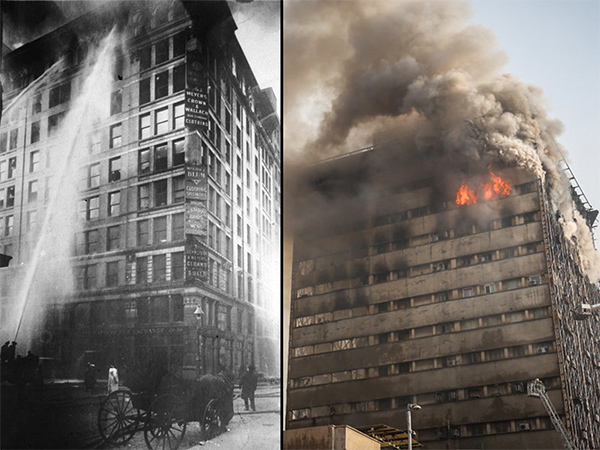Plasco Building in the Iranian capital of Tehran caught fire in early Thursday, January 19, and came down only hours later, with at least 25 people entrapped under the rubble. Efforts are still underway to recover the bodies.
On his Facebook page, Mahan Shirazi, an Iranian architect, urban decision-making expert and researcher currently living in New York City, has made a comparison between Plasco Building collapse and the Triangle Shirtwaist Factory fire [in 1911] and has drawn a number of conclusions about what Iranians can do to prevent such tragic events in the future.
Here are excerpts from Shirazi’s Farsi post:
About a century ago, a blaze swept through a 10- storey building at the centre of New York City, leaving more than 100 dead.
The short ladders of the New York City Fire Department, which were only as tall as the building’s sixth storey, were to blame for a portion of the incident’s unanticipated casualties and damages. This was while, the fire had broken out on the 8th to 10th stories of the Asch Building, where a shirt factory was located.
The building’s fire exit had been so poorly constructed that it failed to bear the weight of the workers who had swarmed to it and, thus, was detached from the wall, resulting in the death of all those who had flocked to it.
The owner of the factory was not the [Iranian] Mostazafan Foundation [the owner of Plasco Building]. Nevertheless, he/she had locked all the doors leading to the fire escape, lest the workers steal something from the factory and escape stealthily through it. It is said about the 1911 tragic event that all the nearby streets were crammed with people, who, although did not have smartphones, could do nothing but to watch the workers dying.
After the catastrophe, the court ordered that the factory owners, who later received $400 for each death from their insurer as compensation, had to pay $75 for each dead worker as their penalty.
Following the disastrous event in the New York City, the citizens started a movement demanding greater security for their buildings and job environment. Those who launched the movement insisted upon their demands so strongly that they could turn the Triangle Shirtwaist Factory fire into a turning point for making fire prevention regulations.
They basically changed the function of their fire department into an organization responsible for enforcing rules and regulations and taking measures to prevent fire, rather than merely extinguishing it.
The New York State Office of Fire Prevention and Control was set up as an organisation actively operating in the municipality of the metropolis. It became mandatory to equip all buildings with fire sprinkler. In addition, tougher regulations were enforced on building fire escapes.
Iran’s National Construction Regulations have not been written by inaccessible people. The members of Tehran City Council are also easy to get in touch with. It is high time to stop moaning and mourning and do something pragmatic to prevent such disasters in the future.
